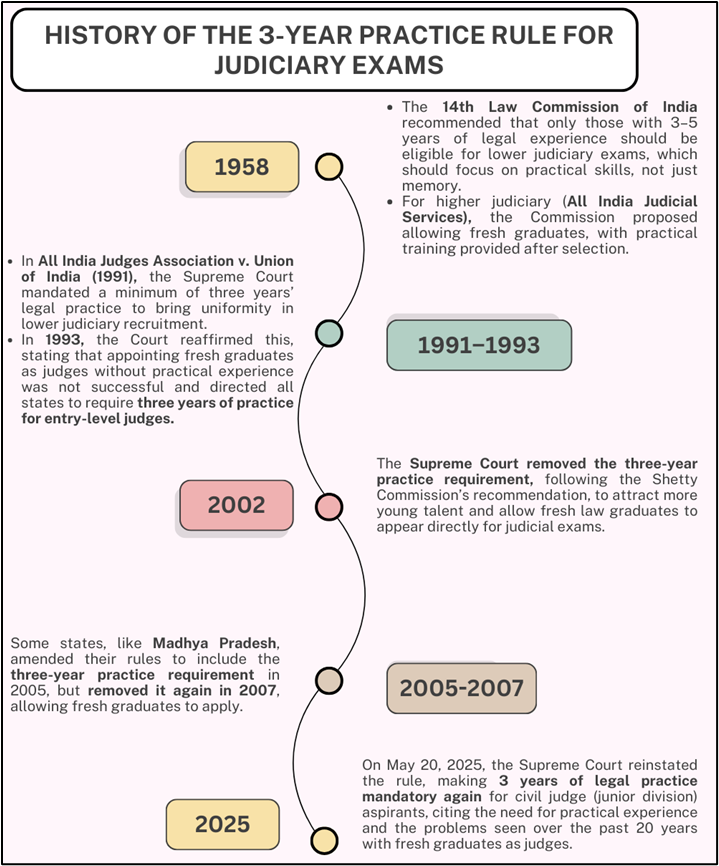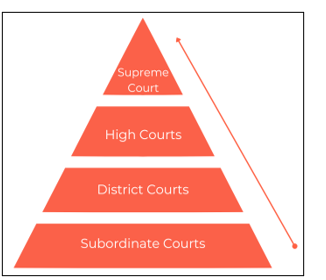Relevance: GS II; Polity; Judiciary;
Why in the News?
The Supreme Court has recently (May 2025) brought back a ‘3-year rule’ for the candidates aspiring to become Civil Judges (junior division).
- This decision means fresh law graduates can no longer apply for judicial exams right after finishing their degrees.

What Is the 3-Year Rule?
- The “3-year rule” mandates that only those who have practiced as advocates for at least 3 years can apply for entry-level judicial positions.
- This means that fresh law graduates can no longer directly appear for judicial service exams (at junior/subordinate divisions) upon graduation.
- They must first gain practical experience in the legal field.
What is the current eligibility criteria for Civil Judge at Junior Division? | How will the rule work? |
|
|

What was the Rationale behind this decision?
- Concerns from High Courts: Multiple high courts reported that new judges without practical experience struggled with the complexities of litigation process and court administration.
- Previous Relaxation: In 2002, the Supreme Court had allowed fresh graduates to apply directly, so that they could attract young talent in the judiciary.
- But this approach was found lacking in preparing judges for the actual realities of the job.
- The 3-judge bench of SC, after considering feedback from high courts and legal experts, concluded that: “Neither knowledge based on law books nor pre-service training can substitute for first-hand experience of court proceedings.”
- It means that the apex court believes that practical exposure brings sensitivity to human problems.
- More experience enhances a judge’s capacity to handle complex cases, which ultimately strengthens the credibility and efficiency of the judiciary.
What are the main arguments for and against the 3-year practice requirement?
Arguments For:
- Practical Experience: The Judges need real courtroom experience (in-fact should have) to truly understand legal procedures and handle cases well.
- Practical work experience as a lawyer helps new judges make better decisions and deal with complex legal issues.
- Quality of Judgments: SC found that fresh graduates often lack the maturity and practical skills needed for judging serious matters like life and property.
- Filtering for Seriousness: Having 3 years of practice ensures only serious and dedicated candidates, who have shown commitment to law, become judges.
- This rule is meant to improve the quality of judgments and make sure judges are ready for the job from day one.
Arguments Against:
- Delayed Entry and Limited Opportunities: Some of the specialized law courses designed to prepare students for direct entry into the judiciary (such as the 5 year BA LLB Honours in ‘Adjudication and Justicing’ at Maharashtra National Law University) will see diminished immediate relevance.
- Further, the 3-year rule makes it harder for new law graduates to become judges quickly.
- Secondly, the exams aren’t held regularly and due to this age limits can stop them from applying at a later stage.
- Barrier for Marginalized and Less Privileged: It is especially tough for students from poorer backgrounds, as not everyone can afford to work for three years in entry-level low-paying or unpaid legal jobs.
- Loss of Young Talent: The rule may push talented young graduates away from judicial careers because they have to wait longer and face uncertainty, making other jobs more appealing.
- Alternative Solutions: Some opponents suggest that instead of this strict rule, the system should focus on holding exams regularly, giving better training after selection, and raising age limits to give more people a fair chance.
Conclusion: The reinstatement of the 3-year rule marks a significant shift in judicial recruitment policy. While it aims to ensure that new judges are better prepared for the demands of their role.
- It also represents a considerable setback for fresh law graduates who aspired to join the judiciary immediately after completing their studies.
- The long-term impact will depend on how legal education and early career pathways adapt to this new reality.





